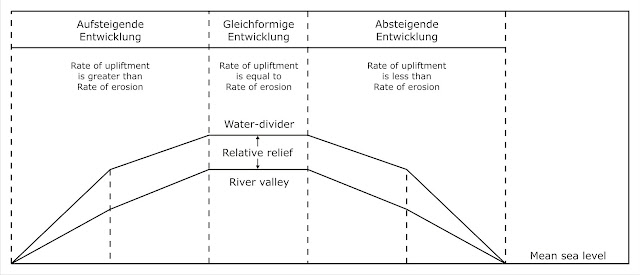One of the important sub-discipline of physical geography is geomorphology, which basically elucidate about the origin, development, evolution of earth surface in terms of landscape, and lots of related topics. One such issue is the discussion of erosion cycle of landscaped, that's the topic of interest for this article.
Famous geologist as well as geomorphologist Walther Penck criticized the Davisian theory about the Geographical Cycle of Erosion which is based on time-dependent stages of landscape development, and presented his own theory of the morphological analysis for the evolution of landscape.
The main theme of his theory was that landscape evolves by the combined function and proportional ratio between upliftment of land by endogenic forces and the erosion of uplifted land by exogenic forces at the same time.
According to British geographer Richard J. Chorley,
Penck believed that landforms should be interpreted by means of ratios which might be expected to occur between erosional (exogenic) process and diastrophic (endogenic) process.
Types of relation between endogenic and exogenic forces
Penck mentioned three types of relation between the upliftment of land through endogenic forces and erosion of land through exogenic forces.
- Rate of upliftment > Rate of erosion. This results the formation of convex slope or waxing slope.
- Rate of upliftment = Rate of erosion. This is the cause of development of uniform slope as both of the forces take part being equally active.
- Rate of upliftment < Rate of erosion, which yields the concave slope or wanning slope.
A basic line-out of the Landscape Evolution Theory after W. Penck
In his theory, Penck explained that the erosion process will begin through the upliftment of an eroded plainland which he called ‘Primarumpf’. He also postulated his theory throughout three stages like that of the theory of W.M. Davis, but Penck used the German term ‘entwicklung’ which means ‘development’, instead of the term ‘stage’.
1. Aufsteigende Entwicklung
The first type of previously mentioned relation is observed– rate of upliftment is greater than the rate of erosion. As the land uplifts rapidly, accordingly the intensity of erosion gradually increases which consequently develops waxing slope.
Along with the upliftment, consequent increase of the channel gradient, kinetic energy, river flow velocity, and the increase in discharge rate, degradation of the river valley starts with the accelerated rate of bottom erosion by the rivers. This gradually develops the V-shaped river valley. The valley sides are characterized by convex slopes.
All these cause the increase of absolute relief from mean sea level. Thus Aufsteigende Entwicklung depicts the stage of convex slope development.
2. Gleichformige Entwicklung
Gleichformige entwicklung refers to the stage of uniform slope development, because land upliftment rate and erosion rate stay equally active during this period. Due to the uniform rate of valley deepening and lowering of the summits of water-dividers, absolute relief and relative relief remain constant during this phase.
3. Absteigende Entwicklung
It is the extreme period of the landscape evolution process. Erosion increases as the upliftment rate of land comes down.
During this phase, the absolute relief from mean sea level decreases because of the absence of upliftment rate, but continuous downwasting of the water-dividers. The upper portion of the valley sides maintains its steep rather than the gradual lowering of ridge crest, that is called the ‘gravity slope’. In the other side, lower portion of the valley sides are called ‘haldenhang’ or ‘wash slope’. The water-dividers continues to be eroded in the ultimate phase and the remainings are called ‘inselberg’.
It results to the progressive declination of the landscape, that develops concave slope which he mentioned as wanning slope.
Chronologically the landscape reachs to the base level of erosion. The final landscape is characterized by haldenhang, piedmont treppen and sometimes with disjunct inselberg. The whole scenario, as designated by Penck, is called ‘Endrumpf’.
Evaluation
Walther Penck formulated his theory quite more analytically than that of the theory of Davis. Penk illuminated in his theory about the correlation between upliftment rate and erosion rate, which led to the rise of functional approach as well as functional equilibrium theories.



Post a Comment
Please do not enter any spam link in the comment box